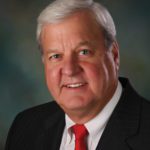
Home » Tri-City leaders push grout as better, faster, cheaper approach to Hanford’s low-level tank waste
Tri-City leaders push grout as better, faster, cheaper approach to Hanford’s low-level tank waste

April 13, 2022

A coalition of high-profile Tri-City business and civic leaders is pushing Hanford managers and regulators to encapsulate low-level tank waste in grout rather than glass, calling grout a better, faster and cheaper approach to cleaning up the nuclear reservation.
Northwest Energy Associates, a nonprofit formed in 2020, is led by Gary Petersen

in partnership with Bob Ferguson and Bill Lampson. It formed to draw attention to the cost of vitrification, to the Hanford budget and to promote grouting as the best solution to handling the low-level waste that comprises most of the tank waste held at the Central Plateau.
The group operates under the banner “Clean Up Hanford Now.”
The 2022 federal budget appropriates nearly $2.6 billion for the Hanford cleanup and includes funding for the next phase of the test bed initiative to prove the efficacy of grouting waste.
The U.S. Department of Energy’s spendy new Waste Treatment and Immobilization Plant is still needed for high-level waste, Clean Up Hanford Now argues.
The argument for grout
Grouting, the group argues, is the financially responsible alternative to vitrification and will let the community move to a post-cleanup economy. They want to see a 1999-approved master plan for the site put into action, allowing research, economic and recreational use of some of the 580-square-mile Hanford reservation.
“If not us, who?” asked Petersen, president of the NEA board. Petersen led efforts to keep federal dollars flowing to the site as vice president for government affairs at the Tri-City Development Council until he retired in 2017.

Bill Lampson, CEO of Lampson International, and Bob Ferguson, a former DOE Deputy Assistant Secretary and Energy Northwest executive, serve as co-chairs. Ferguson remains heavily involved while he recovers from a stroke.
Rounding out the team are Kate Lampson, also of Lampson International, and Kathy Lampson, a Tri-City advertising executive and marketing specialist and executive board member of TRIDEC. Former U.S. Reps. Norm Dicks and Sid Morrison serve as advisors. Sallie Ortiz is the science writer.
The group said it aims to collaborate with, not fight, DOE and the Washington Department of Ecology over the best way to treat waste.

Its pro-grout argument rests on the staggering cost to vitrify tank waste and on a 2019 report from the U.S. Government Accountability Office, which said 90% of the 56 million gallons of waste generated by the production of plutonium for the U.S. nuclear weapons arsenal could be treated with grout at a fraction of the cost of vitrification.
DOE intends to vitrify half of the low-activity waste under terms of the 1989 Tri-Party

Agreement, reached between the state Department of Ecology, Department of Energy and Environmental Protection Agency.
GAO studied the challenge of addressing waste held in 177 single- and double-shelled tanks on the Central Plateau at Congress’ request and concluded that a new approach is needed.
“Congress should consider specifically authorizing DOE to classify Hanford’s supplemental (low-activity waste) based on risk, consistent with existing regulatory authorities. GAO also recommends that DOE develop updated information on the performance of treating (low-activity waste) with alternate methods, such as grout, before it selects an approach for treating supplemental (low-activity waste),” it wrote.
Vitrification entails mixing waste with glass-forming materials to 2,100 degrees Fahrenheit in stainless steel containers, then storing the logs at a disposal site in central Hanford pending a national repository to accept nuclear waste. DOE and its prime contractor, Bechtel National Inc., plan to begin heating up the first melter in anticipation of a 2023 start.
Speeding up cleanup
For Clean Up Hanford Now, grouting low-level waste offers the clearest path to ending Hanford’s wartime mission and replacing it with a clean energy one.
Leaders said they acted because no one else was.
“We need an advocacy group to get Hanford cleaned up and turned over to new projects,” Petersen said. “We’re trying to speed up the Hanford cleanup.”
In January, the DOE released its 2022 Hanford Lifecycle Scope, Schedule and Cost Report, a detailed document that lays out the history of Hanford and the challenge that lies ahead. The report was produced in compliance with the Tri-Party Agreement and confirms that the cleanup carries a daunting price tag.
It brackets the total cleanup cost – with some caveats – at $320 billion on the low end and $660 billion on the high.
The higher number reflects uncertainty around the vitrification program. Congress sent $2.6 billion to Hanford in 2019, 2020, 2021 and now 2022. The Clean Up Hanford Now team believes it will balk at spending $5 billion or more to fully fund work over many years it will take to put tank waste through the vitrification process.
Hanford already consumes about a third of DOE’s Environmental Management budget, more than any of the 15 other sites across the U.S.
“Congress isn’t going to agree to that,” Petersen said.
Clean energy campus
Treatment is half the Clean Up Hanford Now argument. Readying the site for new missions is the other.
With an eye to the future, they are eager to see Hanford’s acres put back into public use as a clean energy campus for everything from small modular nuclear reactors to a carbon sequestration facility.
A Comprehensive Land Use Plan approved in 1999 spells out some of the new activities that could happen in some of the areas currently behind the fence. The plan was noted in the Federal Register on Nov. 12, 1999.
“Current DOE management and Ecology don’t have a history with it. But it is their plan, and it is approved by Congress,” Petersen said.
Petersen and Kate Lampson cite the 1,641 acres DOE transferred to the Tri-City Development Council in 2016 following years of discussion.
A year later, the economic development agency transferred 1,341 acres to the city of Richland and the Port of Benton, which are working out the details of putting in roads, utilities and other infrastructure for future tenants needing large sites for energy, food and other production facilities.
The transferred acres are dwarfed by the land still contained within the site.
“If you can speed treatment up, you can get to redevelopment,” Petersen said.
Online: cleanuphanfordnow.org.
Hanford
KEYWORDS april 2022





